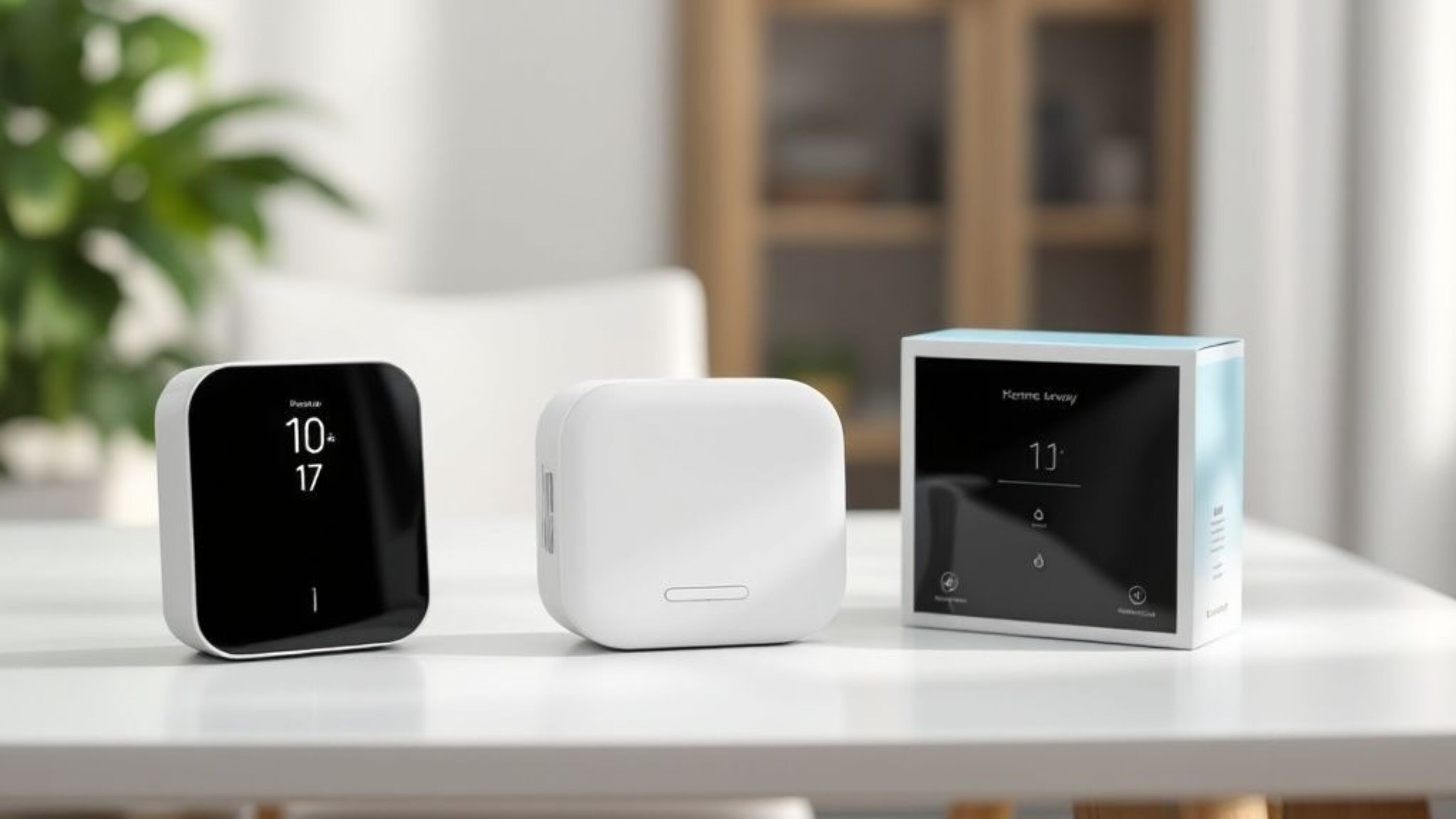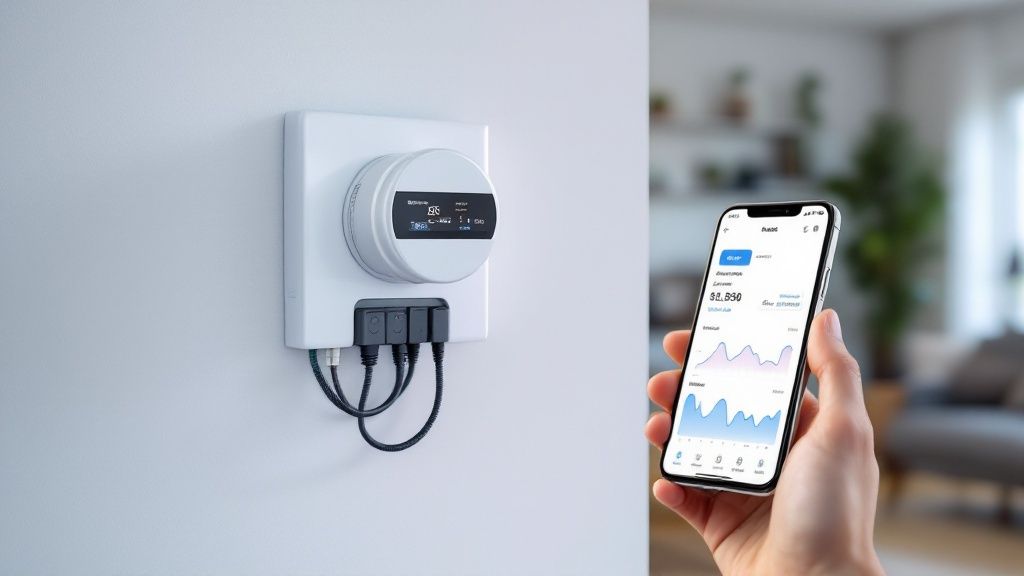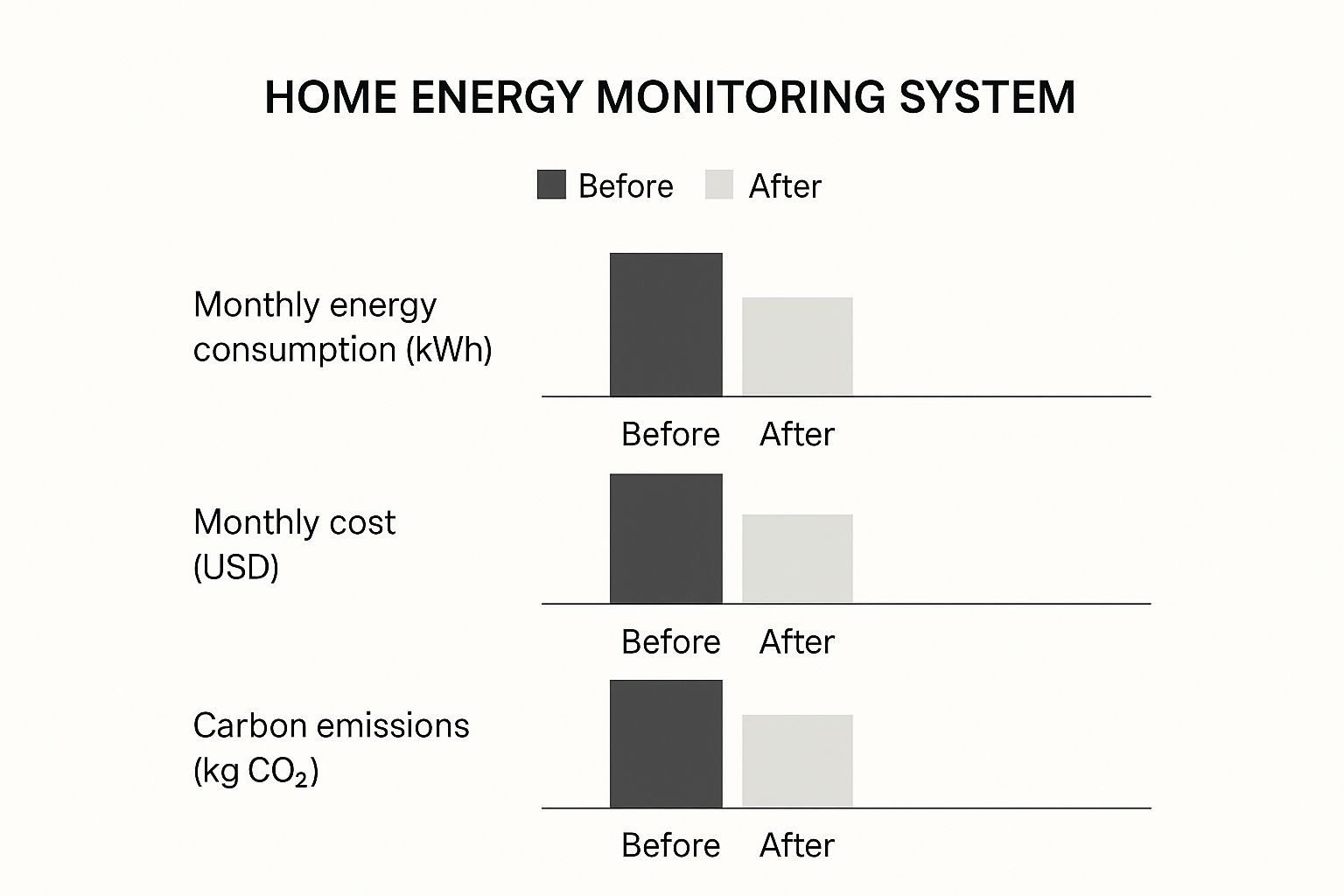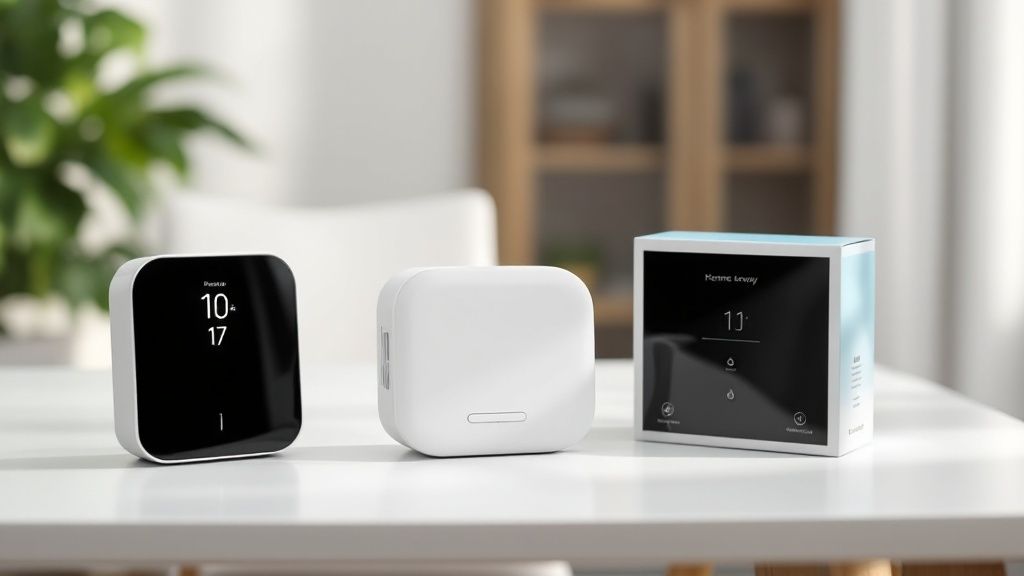Save More with the Best Home Energy Monitoring System

The Smart Home Revolution: Understanding Monitoring Systems
Home energy monitoring systems are changing how Australians manage their electricity use. These systems combine sensors, smart meters, and easy-to-use interfaces, providing homeowners with a clear understanding of their energy habits. This knowledge allows for smarter decisions about electricity usage. Ultimately, it can lead to significant savings and a smaller impact on the environment. This section explores the core components of these systems and explains the key differences between monitoring your whole home and monitoring individual circuits.
Whole-Home vs. Circuit-Specific Monitoring
Selecting the right home energy monitoring system depends on your individual needs and objectives. Whole-home systems give you a complete overview of your total energy consumption. They connect to your smart meter and track the overall electricity flow into your home. This is a great way to understand broad trends and identify general areas for improvement. For instance, you might notice that your energy use increases significantly in the evenings, which suggests opportunities to change habits during those peak hours.
However, for more detailed information, circuit-specific monitors offer a better approach. These devices are installed on individual circuits in your electrical panel. They measure the energy consumed by specific appliances or areas of your home. This lets you pinpoint the biggest energy consumers, like an old refrigerator or an energy-intensive air conditioner. With this specific information, you can take targeted action and implement more effective energy-saving strategies.
Real-Time Data and Actionable Insights
One of the biggest benefits of home energy monitoring systems is access to real-time data. This transforms abstract energy consumption into tangible, actionable information. Instead of a monthly bill that leaves you guessing about usage, you see exactly how much power you are using at any moment. Many systems also offer historical data, so you can track your progress and identify long-term patterns. The Australian smart home market, including these energy monitoring systems, is experiencing rapid growth. It is predicted to increase from US$2.72 billion in 2024 to around US$10.15 billion by 2033. This shows a growing demand for energy efficiency and smart home technology across Australia. You can find more detailed statistics here: Australia Smart Home Market Forecast
This immediate feedback can be extremely motivating. Imagine instantly seeing the impact of turning off lights or using energy-efficient appliances. This direct feedback loop promotes better energy habits and makes it easier to identify and eliminate energy waste. Understanding your energy consumption is the first step to controlling your energy costs and building a more sustainable future.
Beyond the Bill Shock: Real Benefits You'll Experience

A home energy monitoring system offers much more than just a detailed breakdown of your power usage. It empowers you to truly understand and control your energy consumption, leading to significant and tangible benefits. This means you can move beyond simply reacting to high bills and start proactively managing your energy use.
Identifying Energy Vampires and Inefficient Appliances
One of the most immediate advantages of a home energy monitoring system is the ability to detect energy vampires. These are devices that consume power even when they appear to be turned off, such as appliances in standby mode or chargers left plugged in. A monitoring system highlights these often-overlooked energy drains, allowing you to eliminate them and save money.
For example, you might discover your television, even when switched off, is still drawing a small amount of power. This seemingly insignificant drain, multiplied across multiple devices, can add up to a surprising amount over time.
Additionally, a monitoring system helps you identify appliances that are no longer energy efficient. By tracking the energy consumption of individual appliances, you can easily pinpoint those using excessive power. This data-driven approach allows you to make informed decisions about appliance replacements.
This means you can confidently invest in new, energy-efficient appliances, knowing the upgrade will truly make a difference to your energy bills and overall consumption.
Reducing Energy Costs and Mastering Time-of-Use Tariffs
Melbourne homeowners are experiencing real savings through data-informed usage shifts and strategic consumption planning. By understanding peak energy usage times, you can adjust your habits to minimize consumption during these more expensive periods. This is particularly valuable with Australia's increasingly complex time-of-use pricing structures, where electricity rates vary depending on the time of day. Learn more in our article about Sustainable Home Design.
Many households are saving hundreds on their quarterly bills by simply shifting energy-intensive activities, like laundry or dishwashing, to off-peak hours. This empowers you to take advantage of lower electricity rates and reduce your overall energy expenditure.
Monitoring systems can even send notifications reminding you of peak periods, helping you actively manage your energy usage. This proactive approach can lead to substantial savings over time.
To illustrate the potential savings, let's take a look at the following table:
Average Cost Savings with Home Energy Monitoring
This table compares typical household energy costs before and after implementing monitoring systems, showing potential savings across different household sizes.
Household Type | Average Annual Electricity Cost | Typical Savings with Monitoring | ROI Period |
Single Person Apartment | $1,200 | $180 (15%) | 1-2 years |
Couple Apartment | $1,800 | $270 (15%) | 1-2 years |
Family Home (4 people) | $2,500 | $375 (15%) | 1-2 years |
Large Family Home (5+ people) | $3,200 | $480 (15%) | 1-2 years |
As you can see, the potential savings can be quite significant, often paying back the cost of the monitoring system within a couple of years.
Quantifying Your Carbon Footprint and Fostering Mindful Energy Use
Beyond the financial benefits, a home energy monitoring system allows you to quantify your personal impact on carbon reduction. By tracking your energy usage, you can see how your choices directly affect your carbon footprint. This visibility can be a powerful motivator for adopting more sustainable practices.
Furthermore, these systems foster a more mindful relationship with energy in your daily life. Instead of relying on guesswork, you can make decisions based on real data. This greater awareness can lead to significant behavioral changes and create a sense of control over your energy consumption. This empowers you to not just save money, but also contribute to a more sustainable future.
Essential Features That Deliver Actual Results
Choosing a home energy monitoring system can feel overwhelming. With so many options available, it's essential to look beyond the marketing hype and focus on the features that truly matter. Understanding these key features will empower you to select a system that delivers real, tangible results in managing your energy consumption.
Data Granularity and Actionable Insights
The core value of a home energy monitoring system lies in its data granularity. This means how detailed the information is about your energy usage. A system that only shows your total daily usage isn't very helpful. What you really need is a system that breaks down energy use by appliance, hour, or even minute. This level of detail provides the actionable insights you need to make informed decisions.
For example, knowing your overall energy usage is high doesn't tell you why. But if your system shows your hot water system is using a lot of energy, you can investigate. Maybe it's time for a new, more efficient model, or perhaps there's a leak. This granular data transforms information into action.
Smart Notifications and Behavioural Change
Real-time alerts are key to changing energy habits. Imagine getting a notification when your energy use spikes, reminding you to turn off lights or adjust the thermostat. This immediate feedback encourages mindful energy use. Customizable alerts are even better. You could set alerts for when your daily usage goes above a certain limit or if an appliance is left running too long. These personalized notifications make them more relevant and effective.

This infographic shows how a home energy monitoring system can impact your monthly energy consumption, cost, and carbon emissions. The results demonstrate potential savings and environmental benefits from installing such a system. For more information on sustainable home improvements, check out this resource: Eco-Friendly Building Materials
Integration with Smart Home Ecosystems and Solar
Seamless integration with existing smart home platforms is another important factor. Compatibility with voice assistants like Google Assistant or Amazon Alexa allows you to control and monitor your energy usage with voice commands. This makes energy management a more convenient part of your everyday life.
Solar integration is crucial, especially in Australia. A good system should track both solar energy production and household consumption in real-time. This helps you maximize self-consumption and optimize the financial return on your solar investment. The Australian Energy Market Commission (AEMC) is also working to improve access to home energy data. Learn more about this initiative: AEMC Real-Time Data for Consumers.
From Data Overload to Actionable Intelligence
While detailed data is essential, it needs to be presented clearly. A good system should offer actionable intelligence, not just raw data. Look for systems that provide insights you can use to reduce energy consumption. This could include personalized recommendations based on your usage or automated reports that highlight trends and potential savings. This helps you move beyond simply observing data and towards actively managing your energy use for a more efficient and sustainable home.
The following table compares several popular home energy monitoring systems available in Australia. It highlights key features, compatibility options, and pricing to help you make an informed decision.
Comparison of Top Home Energy Monitoring Systems for Melbourne Homes
System Name | Installation Type | Real-time Monitoring | Solar Integration | Smart Home Compatibility | Price Range (AUD) |
Example System 1 | Professional/DIY | Yes | Yes | Google Assistant, Amazon Alexa | $300 - $500 |
Example System 2 | DIY | Yes | Partial | Google Assistant | $200 - $400 |
Example System 3 | Professional | Yes | Yes | Apple HomeKit | $400 - $600 |
This table provides a simplified example and should be populated with real data for actual systems available in the Australian market. Choosing the right system will depend on your individual needs and budget. Be sure to research each system thoroughly to ensure it meets your specific requirements.
From Box to Insights: The Setup Journey Explained
Installing a home energy monitoring system might seem like a big task, but understanding the process can simplify things considerably. This guide provides Australian homeowners with practical advice, addressing common installation hurdles and offering solutions for a smooth setup.
Professional Installation vs. DIY: Making the Right Choice
The initial step is deciding whether to hire a professional electrician or tackle the installation yourself. Some systems, especially those requiring direct connections to your switchboard, mandate a licensed electrician due to Australian electrical safety regulations. This is vital for ensuring compliance and preventing electrical hazards.
However, other systems, like those utilizing smart plugs to monitor individual appliances, are often DIY-friendly. Even with these simpler systems, always prioritize safety. If you're uncertain about any aspect of the installation, consult a qualified electrician. This guarantees your system is installed correctly and adheres to all safety standards.
Tackling Common Installation Challenges in Australian Homes
Melbourne homes often present unique installation challenges. Cramped switchboard spaces can make installing new hardware difficult. Careful planning and potentially upgrading your switchboard may be necessary. Three-phase power setups, common in larger Melbourne homes, introduce additional complexity. This often requires professional expertise to ensure proper wiring and configuration.
Another frequent challenge is network connectivity. Your home energy monitoring system requires a reliable internet connection for data transmission. This might involve extending your Wi-Fi network or using Ethernet cabling. Understanding these potential issues beforehand can save you time and frustration.
Software Configuration and Dashboard Customization
Once the hardware is installed, the next step is software configuration. This typically involves creating an account, connecting the system to your Wi-Fi network, and customizing the dashboard. Most systems offer intuitive interfaces, making this process relatively straightforward. You might be interested in: How to master energy-efficient windows.
However, network connectivity problems can occasionally arise. This might involve troubleshooting your Wi-Fi network or adjusting the system's network settings. Most manufacturers provide online support resources and customer service to help with these issues.
Testing and Ensuring Accurate Readings
After setup, testing your home energy monitoring system is essential. This involves monitoring appliance usage and comparing the readings to your meter. This verifies the system is accurately measuring your energy consumption. If discrepancies are found, double-check the wiring and configuration.
The time from purchase to full operation varies depending on the system's complexity and your installation choice. DIY installations can often be completed in a few hours, while more complex setups might take a day or two. Professional installations usually require scheduling and coordination with the electrician.
By following these steps and proactively addressing potential challenges, you can ensure a smooth installation and start benefiting from your home energy monitoring system. This allows you to understand your energy consumption, pinpoint areas for improvement, and ultimately, lower your energy bills.
Turning Data Into Dollars: Mastering Your Monitoring System

Collecting data is just the beginning. The real power of a home energy monitoring system lies in its ability to translate that data into actual savings. This section explores how Melbourne households are using practical strategies and informed decisions to maximize the benefits of their monitoring systems.
Decoding Consumption Patterns and Identifying Energy Hogs
A home energy monitoring system shines a light on the hidden energy drains in your home. By analyzing your consumption patterns, you can pinpoint appliances using excessive energy. For example, you might discover that your old refrigerator is a major contributor to your electricity bill.
This data empowers you to make informed choices about appliance upgrades, replacing energy-intensive appliances with efficient models. This targeted approach ensures a strong return on investment for energy-efficient appliances.
You can also identify specific usage patterns that contribute to higher bills. Perhaps you see a regular spike in energy use at certain times. This could highlight opportunities to shift energy-intensive activities to off-peak hours. Understanding your household's energy rhythm allows for strategic adjustments that lead to real savings.
Setting Up Smart Alerts and Avoiding Costly Surprises
Personalized alerts are a valuable feature of home energy monitoring systems. You can set thresholds for energy consumption and receive notifications if these limits are exceeded. This helps you catch potential problems before they become major expenses.
An alert could notify you if an appliance is left running too long or if your overall usage surpasses a preset level. This allows you to take immediate action and prevent unnecessary energy waste.
These alerts can be tailored to your needs. You can set alerts for specific times of day or for individual appliances. This customization lets you focus on the most important areas of your energy consumption. Alerts also help you maintain good energy habits and stay on track with your savings goals.
Evaluating ROI on Upgrades and Optimizing Existing Systems
Monitoring data is crucial for evaluating the return on investment (ROI) of energy-efficient upgrades. By comparing energy consumption data before and after an upgrade, you can accurately measure its impact. This data-driven approach helps you make smart home improvement decisions and maximize your savings.
This approach goes beyond just appliances. Use your monitoring system to optimize existing systems, like heating and cooling. Identify the most efficient temperature settings for your home, balancing comfort and energy savings.
The market for energy management systems, including home energy monitoring, is expected to grow significantly in Melbourne. Explore this topic further. This growth reflects increasing technology adoption and environmental awareness among Melbourne homeowners.
Seasonal Strategies and Data-Driven Analysis
Australia's diverse climate requires seasonal adjustments to your energy strategy. In the summer, your monitoring system can help manage cooling loads efficiently. By tracking your air conditioner's energy use, you can identify opportunities to optimize its performance.
Similarly, in winter, monitor heating usage to find the most cost-effective way to stay warm. This might involve adjusting thermostat settings, using more efficient heating methods, or improving insulation.
Many systems offer data export options for data-savvy homeowners. This allows for deeper analysis using spreadsheets or other data analysis tools. Compare your energy usage to local benchmarks and calculate the financial impact of your choices in real time. This detailed analysis offers valuable insights, empowering you to optimize energy consumption for maximum savings. By turning data into action, you can take control of your energy future and create a more sustainable home.
Powering Your Future: Monitoring Systems and Renewables
For Melbourne homeowners with solar panels, a home energy monitoring system adds incredible value. It takes a standard solar setup and turns it into a personalized energy-saving powerhouse. This section explores how these systems help you optimize solar energy use, manage battery storage, and even participate in programs like Virtual Power Plants.
Maximizing Solar Self-Consumption With Real-Time Data
Real-time production and consumption data is essential for getting the most from your solar investment. A home energy monitoring system shows you precisely how much energy your panels are generating and how much your home is using at any given time. This empowers you to shift energy-intensive activities, like laundry or running the dishwasher, to daylight hours. This coincides with peak solar production.
This practice is called self-consumption. It directly reduces your reliance on the grid and increases your solar savings. For example, imagine seeing your solar panels producing ample power on a sunny afternoon. You could then choose to run the dishwasher, directly using the sun's energy instead of drawing from the grid. This proactive approach can significantly lower your electricity bills.
Optimizing Battery Storage For Peak Performance
For homes equipped with battery storage, a monitoring system is essential for maximizing its effectiveness. By understanding your daily energy usage, you can program your battery to charge during periods of high solar generation. Then, you can discharge it during peak pricing periods. This intelligent charge/discharge cycling optimizes battery performance and further lessens your reliance on the grid.
This strategy becomes particularly effective when combined with time-of-use tariffs, where electricity prices change throughout the day. This means you can avoid drawing expensive grid power during peak hours by using stored solar energy. You might be interested in: How to master energy-efficient home design. This smart management approach ensures your battery investment delivers maximum financial and environmental benefits.
Participating in Virtual Power Plants and Monetizing Your Energy
Virtual Power Plants (VPPs) are a growing trend in Melbourne. These networks combine the energy resources of numerous homes, creating a decentralized power source. This decentralized source supports the grid during times of peak demand. Advanced monitoring systems are key to VPP participation. They allow homeowners to contribute excess solar energy and potentially earn revenue for these grid services.
This innovative approach transforms individual households into active participants in the energy market. By contributing to grid stability, you not only reduce your own energy costs but also contribute to a more resilient and sustainable energy future for Australia. This turns your home solar system into a potential income generator.
Future-Proofing Your Home for Electric Vehicles and Emerging Tech
As Australians increasingly adopt electric vehicles (EVs), integrating them with home energy systems becomes crucial. Home energy monitoring systems are vital for this integration. They allow you to track EV charging costs, optimize charging schedules to use solar power, and even participate in future vehicle-to-grid (V2G) programs. V2G technology allows your EV's battery to power your home, further increasing energy independence.
This forward-thinking approach puts your home at the forefront of Australia's changing energy landscape. By using these emerging technologies and integrating them with a smart monitoring system, you can create a truly sustainable and efficient home energy ecosystem. This benefits your wallet and contributes to a greener future.
The Road Ahead: What’s Next for Home Energy Monitoring
The future of home energy monitoring in Australia looks promising, with exciting developments poised to change how we manage our energy consumption. Let's explore some of the key trends emerging in home energy management, from the power of Artificial Intelligence (AI) to upcoming regulatory changes and the growing integration with smart home technology.
AI and Machine Learning: Predicting Your Energy Future
AI and Machine Learning are transforming home energy monitoring from simple tracking into predictive management. These technologies analyze your past energy usage to forecast your future needs, enabling proactive adjustments and optimized energy consumption.
Imagine your system predicting a spike in energy demand during a heatwave. It could then pre-cool your home during off-peak hours, saving you money and ensuring comfort. This shift towards predictive capabilities marks a significant advancement in home energy management.
Regulatory Changes: New Opportunities for Energy Management
Changes in Melbourne's energy market regulations could create new opportunities for homes equipped with monitoring systems. Demand response programs, for example, offer incentives for reducing energy use during peak times.
With a home energy monitoring system, you can automatically participate in these programs, earning credits or discounts while contributing to grid stability. There's also growing discussion around peer-to-peer energy trading, where households could buy and sell excess solar power. Home monitoring systems would be essential for facilitating such transactions.
Seamless Smart Home Integration: Automating Energy Efficiency
Home energy monitoring systems are becoming increasingly integrated with broader smart home ecosystems, creating a truly automated and efficient home. Picture your lights dimming automatically when solar production is low, or your thermostat adjusting based on real-time energy prices.
This seamless integration between systems optimizes both comfort and cost savings, representing a major step forward in smart home technology.
The Renewable Energy Revolution: Solar, Batteries, and the Grid
Melbourne’s transition to renewable energy is fueling innovation in home energy monitoring. New systems offer advanced features for solar optimization, including precise production monitoring and consumption matching, ensuring you maximize your solar investment.
Battery management is also becoming more sophisticated. Monitoring systems can now analyze weather forecasts and energy prices to optimize battery charge and discharge cycles, maximizing your energy independence and financial savings. This is particularly important as more Australians adopt solar and battery systems.
Furthermore, monitoring systems are becoming crucial for interacting with the grid. They enable participation in Virtual Power Plants (VPPs) and other grid services, contributing to a more stable and sustainable energy future.
Ready to create a truly intelligent and efficient home? Envy Abode specializes in designing and building luxury homes that seamlessly integrate smart technology, including state-of-the-art home energy monitoring systems. Explore our design and build services to learn more.